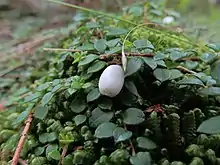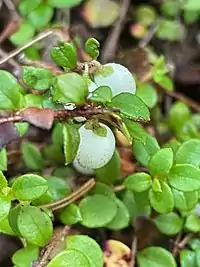Gaultheria hispidula
Gaultheria hispidula, commonly known as the creeping snowberry or moxie-plum, and known to Micmaq tribes of Newfoundland as Manna Teaberry, is a perennial[2] spreading ground-level vine of the heath family Ericaceae. It is native to North America and produces small white edible berries. It fruits from August to September. Its leaves and berries taste and smell like wintergreen.[3]
| Gaultheria hispidula | |
|---|---|
 | |
| Foliage and ripe fruit | |
| Scientific classification | |
| Kingdom: | Plantae |
| Clade: | Tracheophytes |
| Clade: | Angiosperms |
| Clade: | Eudicots |
| Clade: | Asterids |
| Order: | Ericales |
| Family: | Ericaceae |
| Genus: | Gaultheria |
| Species: | G. hispidula |
| Binomial name | |
| Gaultheria hispidula | |
| Synonyms | |
|
Chiogenes hispidula | |
Description

Gaultheria hispidula is an evergreen prostrate shrub that forms a mat of stems and leaves that can reach 1 m (3.3 ft) in diameter and only 10 cm (3.9 in) high.[4] The small leaves, which are under 1 cm (0.39 in) long, are arranged alternately along the stems.[5] The pale green-white flowers are seen in spring, followed by the white berries in August and September. The fruit is white with small darker-colored hair-like growths. The fruit is edible and has an acidic taste.[4]
Distribution and habitat
Gaultheria hispidula grows in acidic and neutral soils in open woodland and forest verges,[4] particularly on wet ground such as in or on the edge of bogs, often near tree stumps. Its original range spread from far northern Canada to as far south as North Carolina, but it has been extirpated from the southerly portions of its original range.
Ecology
It is pollinated by solitary bees, bumblebees, bee-flies, and hoverflies, while chipmunks and deer mice spread the seed.[6]
Conservation status
Like most plants in North America, deforestation and competition with invasive ornamentals (especially shade-loving groundcovers, such as English ivy or winter creeper commonly sold at garden centers) affect the creeping snowberry significantly. As a result, it has been extirpated from some of its original range and classified as rare in several states. Despite this, its international status has been evaluated as secure. This is because it is still quite common in its more northerly range of greater Canada.[5] However, deforestation and exotic invasion are continuing problems that affect all forest species in both Canada and the United States.[7][8]
It is listed as endangered in Maryland and New Jersey, as threatened in Rhode Island, as sensitive in Washington, as rare in Pennsylvania, as presumed extirpated in Ohio,[9] and as a species of special concern in Connecticut.[10]
Uses
The Algonquin people use an infusion of the leaves as a tonic for overeating.[11] They also use the fruit as food.[12] The Anticosti use it as a sedative,[13] and the Micmac decoct the leaves or the whole plant for an unspecified purpose.[14] The Ojibwa people use the leaves to make a beverage.[15]
The leaves can be cooked as a vegetable. The fruits can be eaten raw, baked, or used to make jam.[16]
References
- Maiz-Tome, L. 2016 (2016). "Gaultheria hispidula". IUCN Red List of Threatened Species. 2016: e.T64313540A67729546. doi:10.2305/IUCN.UK.2016-1.RLTS.T64313540A67729546.en. Retrieved 27 January 2022.
- USDA, NRCS (n.d.). "Gaultheria hispidula". The PLANTS Database (plants.usda.gov). Greensboro, North Carolina: National Plant Data Team.
- Peterson Field Guides: Edible Wild Plants, Lee Allen Peterson, 1977
- "Gaultheria hispidula". Plants for a Future. Retrieved 21 May 2011.
- Pennsylvania Natural Heritage Program (PNHP) (2007). "Creeping Snowberry (Gaultheria hispidula)" (PDF). Pennsylvania Plant Species of Concern. Department of Conservation and Natural Resources. Retrieved 22 May 2011.
- Hays, Michael (2001). "Conservation Assessment for Creeping snowberry (Gaultheria hispidula)" (PDF). US Forest Service website. Allegheny National Forest: USDA Forest Service, Eastern Region. Retrieved 21 May 2011.
- "Global Deforestation". University of Michigan. Archived from the original on 15 June 2011. Retrieved 27 May 2011.
- "Canada's Species". Torsten Bernhardt, Museums Assistance Program of Heritage Canada, McGill University. Retrieved 27 May 2011.
- USDA, NRCS (n.d.). "Plants Profile for Gaultheria hispidula (Creeping snowberry)". The PLANTS Database (plants.usda.gov). Greensboro, North Carolina: National Plant Data Team. Retrieved 21 December 2017.
- "Connecticut's Endangered, Threatened and Special Concern Species 2015" (PDF). State of Connecticut Department of Energy and Environmental Protection Bureau of Natural Resources. Retrieved 1 January 2018. (Note: This list is newer and updated from the one used by plants.usda.gov)
- Black, Meredith Jean 1980 Algonquin Ethnobotany: An Interpretation of Aboriginal Adaptation in South Western Quebec. Ottawa. National Museums of Canada. Mercury Series Number 65 (p. 216)
- Black, p.102
- Rousseau, Jacques 1946 Notes Sur L'ethnobotanique D'anticosti. Archives de Folklore 1:60-71 (p. 68)
- Speck, Frank G. 1917 Medicine Practices of the Northeastern Algonquians. Proceedings of the 19th International Congress of Americanists Pp. 303-321 (p. 317)
- Densmore, Frances 1928 Uses of Plants by the Chippewa Indians. SI-BAE Annual Report #44:273-379 (p. 317)
- Elias, Thomas S.; Dykeman, Peter A. (2009) [1982]. Edible Wild Plants: A North American Field Guide to Over 200 Natural Foods. New York: Sterling. p. 153. ISBN 978-1-4027-6715-9. OCLC 244766414.
